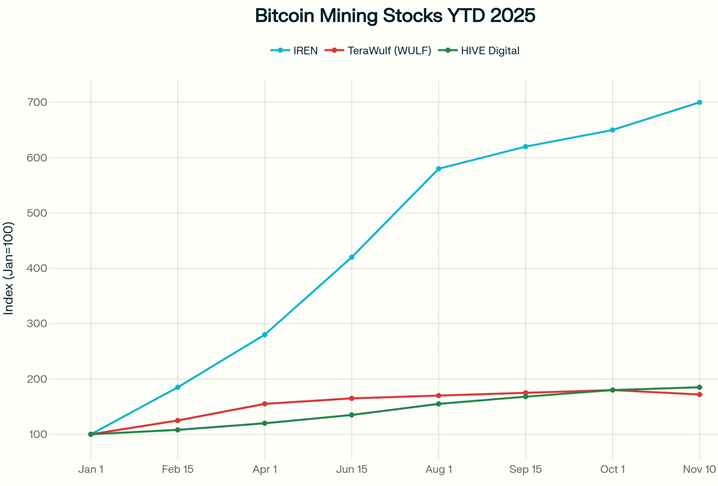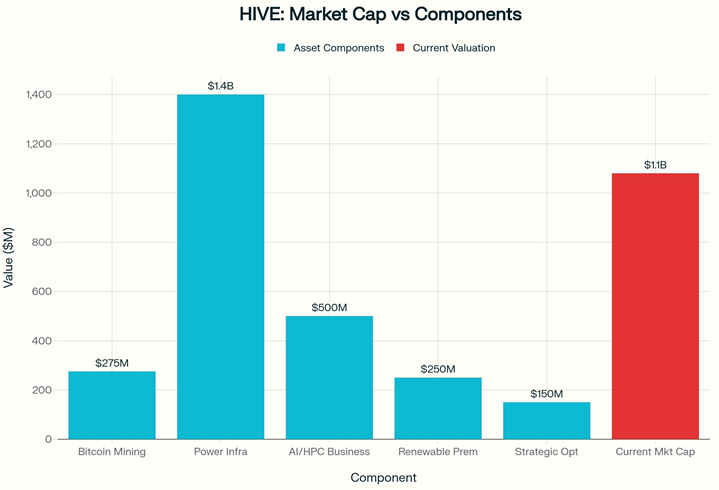S&P 500 jumps as tech rallies as investors eye end of government shutdown
Bitcoin miners just became unexpected winners in the AI race, and it has little to do with cryptocurrency
When IREN’s (NASDAQ:IREN) stock rallied more than 600% this year, many chalked it up to another crypto run. Then, in early November 2025, Microsoft agreed to a $9.7 billion deal. The target was not Bitcoin mining. It was grid-connected computing power.
The AI boom has a basic, stubborn constraint. It is not a lack of GPUs. It is not chip allocation. The binding limit is more fundamental and slower to fix: electrical power. Bitcoin miners happen to control a meaningful share of it.
The 5-Year Problem No One Talks About
When Amazon (NASDAQ:AMZN), Microsoft (NASDAQ:MSFT), or Google (NASDAQ:GOOGL) moves to build a new AI data center, the first step is an interconnection request to the local utility. The next step is waiting.
Average grid interconnection timelines in the U.S. have stretched to five to seven years, according to FERC data. A single hyperscale AI site can require one to two gigawatts of capacity, enough to power hundreds of thousands of homes, which can push timelines even longer. Transformer components alone face multi‑year backlogs.
Meanwhile, projected AI data center power demand rises from about 4 gigawatts in 2024 to roughly 123 gigawatts by 2035, a 30x increase, per Deloitte. Even if approvals started today, supply would lag demand well into the 2030s.
This is what will shape the AI race: not who builds the best model or buys the most GPUs, but who can connect power to racks on a short clock.
Enter an unlikely group of infrastructure owners: Bitcoin mining companies.
The Accidental Infrastructure Advantage
Miners did not set out to control AI infrastructure. They chased cheap power for energy‑intensive mining, often in remote regions. They are co‑located by hydro in Paraguay, geothermal in Iceland, and wind in West Texas. They went where electricity was stranded and priced below the grid.
Along the way, they solved the exact problem that is now slowing AI deployments. They already own substations, grid interconnections, and long‑term power contracts. Those take years to secure from scratch.
Public Bitcoin miners collectively control roughly 14 gigawatts of grid‑connected capacity. That is more than 10% of the AI data center capacity projected through 2030, already wired and running. Converting these sites to AI workloads can take nine to twelve months, not half a decade.
The market has noticed. When IREN disclosed its Microsoft agreement in November, the contract economics were AI infrastructure, not crypto. Microsoft will pay about $1.94 billion per year over five years, consistent with hosting roughly 1,300 megawatts of AI compute. IREN’s market value moved from about $7 billion to $16.5 billion after the news, a 135% re‑rating tied to power infrastructure, not Bitcoin.
Valuation frameworks are shifting with it. Miners pivoting to AI are trading near $6 million per megawatt of capacity, while pure Bitcoin miners sit closer to $3 million. The premium reflects a simple idea: reliable power and grid access are more valuable than the coins those facilities once mined.

Bitcoin Mining Stocks Dramatically Outperform in 2025 - IREN Up 600%, TeraWulf Up 72%, HIVE Up 85%
The Difficulty Squeeze
As of early November 2025, Bitcoin network difficulty sits near 155.97 terahashes, a record. At that level, many U.S. grid‑rate miners break even around $111,000 per Bitcoin. Margins narrow, and only the most efficient operations stay profitable. For many, an AI pivot is not a side project. It is the path to sustainable cash flow.
This is where a dual‑engine model becomes attractive. Mining provides near‑term cash generation and optionality. AI hosting and high‑performance computing shift the long‑term value driver to recurring revenue.
HIVE Digital: The Renewable Power Angle
HIVE Digital Technologies (TSXV:HIVE) (NASDAQ: HIVE) is a $1.08 billion company that illustrates how this re‑rating can work.
Unlike ASIC‑only miners such as Marathon Digital or Riot Platforms, HIVE has GPU roots. It mined Ethereum before the 2022 switch to proof‑of‑stake. That background means in‑house experience with GPU thermal design, networking, and HPC workloads. Competitors starting AI pivots from ASIC mining are building those skills now, which can add time and cost.
HIVE’s structural edge is power. Its major facilities run on renewable energy.
The Grand Falls site in New Brunswick uses an 80‑megawatt substation powered by a grid that is roughly 98% renewable. HIVE also operates at Paraguay’s Itaipú Dam and Sweden’s Boden campus, which benefits from hydro and cold‑climate cooling.
The result is cost. Where grid power might run near $0.08 per kilowatt‑hour, HIVE’s renewable contracts land closer to $0.02–0.03. Those cushion margins whether Bitcoin trades at $80,000 or $150,000. For AI customers with carbon‑neutral mandates, renewable power can support 15–25% pricing premiums over fossil‑powered peers.
At full utilization, Grand Falls’ 80 MW could theoretically produce around $144 million in annual AI/HPC revenue using $1.8 million per MW benchmark pricing. That is roughly $60 million more than equivalent Bitcoin mining, with steadier margins. In practice, the ramp is staged. HIVE’s current 5 MW enterprise deployment with Bell Canada shows measured rollout.
The Canadian Sovereign Cloud Angle
HIVE’s partnership with Bell Canada to build a “sovereign AI cloud” aligns with a broader trend. NATO‑aligned countries and large enterprises are treating AI infrastructure as a strategic asset. Canada positions itself as a trusted alternative for organizations with data sovereignty concerns. Renewable‑powered facilities on Canadian soil, paired with Bell’s network, give HIVE a credible position in this “trusted infrastructure” segment that ASIC‑focused peers cannot easily copy.
Execution, The Hard Part
HIVE still needs to convert facilities on schedule, win larger customers against MARA, RIOT, and IREN, and navigate GPU allocation. NVIDIA (NASDAQ:NVDA) Blackwell supply is tight through 2025. Preferred channels help, but they do not guarantee hardware.
Scale is another factor. HIVE is 1/4 the market cap of Marathon Digital ($4.3B), which can matter when negotiating with hyperscalers. It is also smaller than the largest U.S. miners, which can make five‑comma contracts harder to land. Its footprint spans Canada, Sweden, Iceland, and Paraguay, while U.S. AI demand clusters in Texas, Arizona, and Northern California. That geography can create operational frictions.
The offset is optionality. If AI demand softens, HIVE can lean on mining. If Bitcoin weakens, AI hosting can fill the gap. The two‑engine setup lowers single‑factor risk compared with all‑in pivots that shut down mining entirely.
The Stranded Power Opportunity
Texas curtails an estimated 15–20% of wind power each year, roughly 8–10 terawatt‑hours. Curtailed power can price near $0.02 per kWh versus $0.08 for standard grid retail. Operators able to absorb this supply systematically can lock in structural cost advantages.
HIVE’s renewable sites are positioned to capture a share of that arbitrage. This is not a temporary cycle; it stems from how and where renewable power is generated and how transmission lines are built.
Valuation: Sum of the Parts
A simplified look at HIVE’s pieces shows a gap between assets and market price:
|
Component |
Valuation |
|
Bitcoin mining operations (23 EH/s) |
$250–300M |
|
Power infrastructure (400+ MW pipeline) |
$1.2–1.6B at $3–4M/MW |
|
AI/HPC business (6,000 GPU target) |
$400–600M at market multiples |
|
Renewable energy premium |
$200–300M |
|
Strategic optionality (M&A target) |
$100–200M |
|
Total implied value |
$2.15–3.0B |
|
HIVE current market cap |
$1.08B |
|
Implied discount |
48–64% |
The range reflects uncertainty around timing, contracts, and execution. Street targets sit roughly $6.50 to $8.50 per share, implying 30–70% upside if milestones land.
Near‑Term Catalysts
HIVE reports fiscal Q2 2026 results on Nov. 14, 2025, with earnings call on Nov. 17 at 8:00 a.m. ET. This will be the first update covering the six months through Sept. 30, 2025. Investors should watch for the first material AI revenue contribution (the Bell Canada 5 MW facility deployment began in August), so Q2 results should reflect 1-2 months of operational AI revenue, validating the infrastructure pivot thesis.
Watch for:
- Initial AI revenue contribution, even 10–15%
- Bell Canada deployment progress and new customer pipeline
- Conversion milestones at Boden and other sites
- GPU procurement updates and NVIDIA partnership progress
- Any new hyperscaler partnerships beyond Bell
Even modest AI revenue can shift the market view from “pivot in progress” to “operating track record.”

HIVE Digital: 48-64% Valuation Discount to Sum-of-Parts Analysis
The Trade
The mining headline is simple. The real story is infrastructure. In a power‑constrained world, the edge shifts from algorithms and chips to megawatts and interconnects.
NVIDIA can build the GPUs. Microsoft can train the models. None of them can skip a five‑ to seven‑year utility queue.
Miners already waited in that line. Many built the assets in advance.
For HIVE, the dual‑engine model (mining for cash flow and AI for recurring revenue) improves resilience. The renewable footprint adds cost and pricing advantages. The risks are real, but manageable if execution stays on track.
If HIVE reaches even 70% of its AI targets by 2027, valuation could move toward 8-12x forward EBITDA, closer to infrastructure peers. That implies a market cap that could rise toward $2-3 billion. Stronger execution and hyperscaler wins would push higher.
Investment Thesis Summary
The Bull Case:
- 14 GW miner-controlled power vs. 5-7 year interconnection wait times = structural moat
- Microsoft’s $9.7B IREN deal validates mining-to-AI infrastructure pivot
- HIVE’s renewable advantage + GPU heritage = competitive differentiation
- 48-64% valuation discount to sum-of-parts implies asymmetric risk/reward
- Catalyst timeline: Q2 earnings, November 14-17, could inflect narrative
The Bear Case:
- Execution risk: HIVE is smaller than MARA/RIOT, harder to win mega-deals
- GPU supply remains constrained through 2026; no guaranteed allocation
- Geographic spread (Canada/Sweden/Paraguay) not aligned with US AI demand
- Pure-play AI pivots (IREN) have already moved; they may command premium multiples
- Recent share dilution (53.67% increase) reflects ongoing capital needs
The Verdict: HIVE represents a rare asymmetric bet: Infrastructure play masquerading as crypto stock, with genuine competitive moat (renewable power + GPU expertise + grid access), meaningful upside catalysts (earnings November 17), and reasonable entry point (trading below sum-of-parts). Risk profile is moderate for a mid-cap equity; reward profile is substantial if the AI pivot executes as planned.
For sophisticated investors comfortable with execution risk and 18-24 month holding periods, HIVE offers a compelling risk-adjusted opportunity in a structurally advantaged sub-sector.
